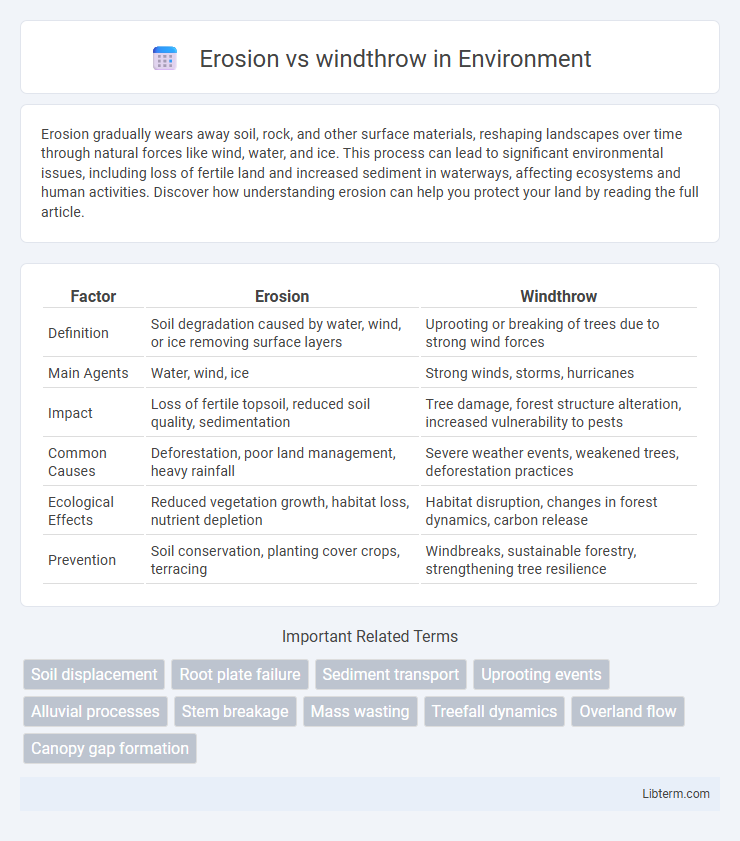Erosion gradually wears away soil, rock, and other surface materials, reshaping landscapes over time through natural forces like wind, water, and ice. This process can lead to significant environmental issues, including loss of fertile land and increased sediment in waterways, affecting ecosystems and human activities. Discover how understanding erosion can help you protect your land by reading the full article.
Table of Comparison
| Factor | Erosion | Windthrow |
|---|---|---|
| Definition | Soil degradation caused by water, wind, or ice removing surface layers | Uprooting or breaking of trees due to strong wind forces |
| Main Agents | Water, wind, ice | Strong winds, storms, hurricanes |
| Impact | Loss of fertile topsoil, reduced soil quality, sedimentation | Tree damage, forest structure alteration, increased vulnerability to pests |
| Common Causes | Deforestation, poor land management, heavy rainfall | Severe weather events, weakened trees, deforestation practices |
| Ecological Effects | Reduced vegetation growth, habitat loss, nutrient depletion | Habitat disruption, changes in forest dynamics, carbon release |
| Prevention | Soil conservation, planting cover crops, terracing | Windbreaks, sustainable forestry, strengthening tree resilience |
Understanding Erosion and Windthrow
Erosion is the gradual removal of soil and rock by natural forces such as water, wind, and ice, resulting in landscape changes and reduced soil fertility. Windthrow refers to the uprooting or breaking of trees caused by strong winds, impacting forest structure and ecosystem stability. Understanding the distinct processes and effects of erosion and windthrow is crucial for effective soil conservation and forest management strategies.
Key Differences Between Erosion and Windthrow
Erosion primarily involves the gradual removal of soil or rock by water, wind, or ice, leading to landscape changes and soil degradation, whereas windthrow refers to trees being uprooted or broken by strong winds, causing forest disturbance. Erosion affects both soil composition and topography over time, while windthrow results in immediate physical damage to forest stands. The impact of erosion is widespread and long-term, contrasting with the localized and sudden nature of windthrow events.
Causes of Erosion
Erosion primarily results from natural forces such as water runoff, wind, and ice, which wear away soil and rock surfaces over time. Human activities like deforestation, agriculture, and construction accelerate erosion by disrupting vegetation cover and soil stability. Unlike windthrow, which is caused by strong winds uprooting trees, erosion focuses on the gradual displacement of soil and sediment.
Causes of Windthrow
Windthrow is primarily caused by strong winds that uproot or snap trees, often exacerbated by shallow root systems and saturated soils from heavy rainfall. Soil erosion weakens tree anchorage by washing away nutrients and soil structure, increasing vulnerability to windthrow during storms. Forest management practices, such as clear-cutting and poor thinning, can also contribute to windthrow risk by altering stand stability and exposure.
Impact of Erosion on Ecosystems
Erosion significantly disrupts ecosystems by removing nutrient-rich topsoil, leading to reduced plant growth and habitat loss for wildlife. This process increases sedimentation in water bodies, harming aquatic life and altering water quality. Unlike windthrow, which causes localized tree uprooting, erosion affects entire landscapes, resulting in long-term degradation of soil structure and biodiversity.
Windthrow Effects on Forests
Windthrow significantly impacts forest ecosystems by uprooting trees and disrupting canopy structure, leading to increased light penetration and altered microclimates that influence species composition. The resulting gaps create opportunities for pioneer species to establish, accelerating successional processes but also increasing vulnerability to erosion and invasive species. This disturbance can modify nutrient cycles and soil stability, often requiring long-term recovery efforts to restore forest health and biodiversity.
Prevention and Control of Erosion
Erosion control primarily involves stabilizing soil through vegetation cover, mulching, and terracing to prevent sediment displacement caused by water and wind. Techniques such as planting deep-rooted grasses and constructing physical barriers like riprap and silt fences effectively reduce surface runoff and soil loss. Proper land management practices, including contour plowing and maintaining buffer strips along waterways, further minimize erosion risks and preserve soil integrity.
Mitigating Windthrow Damage
Mitigating windthrow damage involves strategies such as maintaining mixed-species forests, which enhance structural diversity and reduce susceptibility to strong winds. Implementing buffer zones with windbreak trees and applying selective thinning techniques can also stabilize stands and minimize tree uprooting. Monitoring soil conditions and ensuring appropriate root development further strengthen trees against windthrow impacts.
Human Activities Influencing Erosion and Windthrow
Human activities such as deforestation, urban development, and agriculture significantly increase soil erosion by removing vegetation cover that stabilizes the soil. Logging and road construction disrupt root systems, making forests more susceptible to windthrow by weakening tree anchorage during storms. Land-use changes that degrade soil structure exacerbate erosion rates and elevate the risk of windthrow events, impacting ecosystem stability and forest health.
Comparing Long-Term Consequences
Erosion leads to the gradual loss of soil nutrients and structure, resulting in decreased land fertility and increased vulnerability to water runoff over time. Windthrow causes immediate tree uprooting and canopy gaps, disrupting forest ecosystems but potentially enhancing biodiversity through habitat creation. Long-term, erosion severely degrades soil quality affecting agriculture and hydrology, whereas windthrow prompts dynamic forest regeneration and alters landscape heterogeneity.
Erosion Infographic

 libterm.com
libterm.com